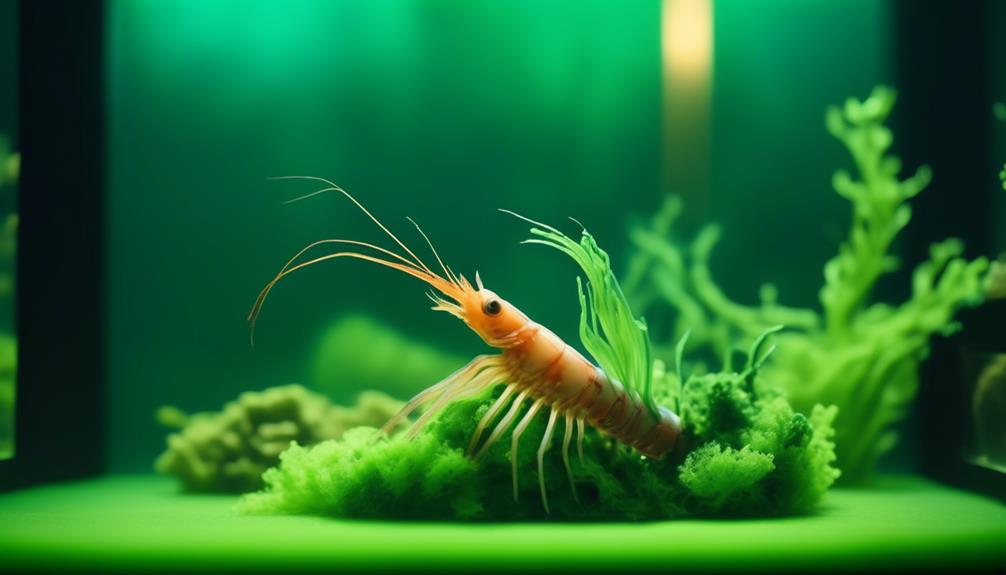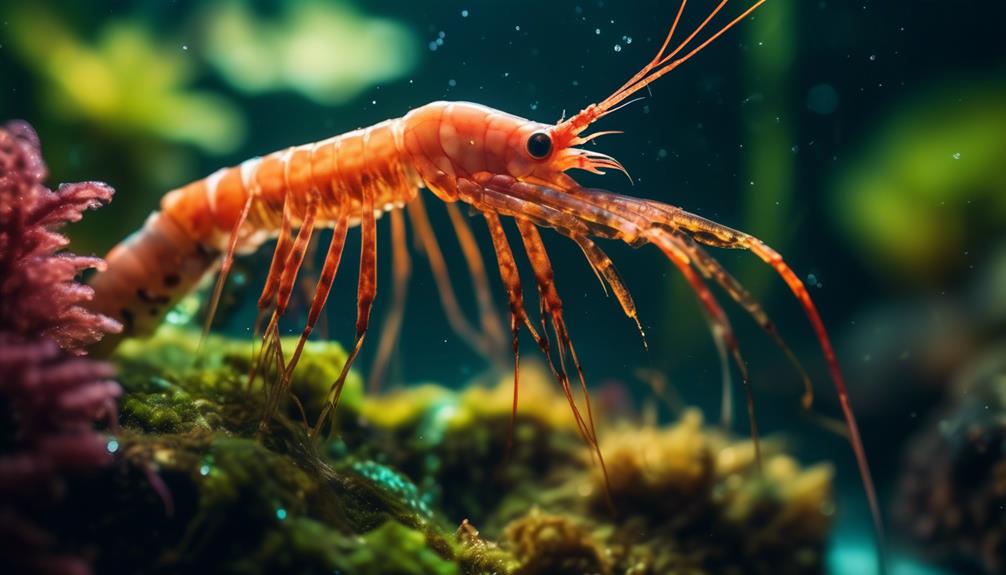When it comes to creating a thriving and visually appealing aquarium, selecting the perfect shrimp species is crucial. With a plethora of options available, it can be overwhelming to determine which shrimp will best suit your aquarium's needs.
In this article, we will explore various categories of shrimp, each with their own unique characteristics and care requirements. From beginner-friendly species to more challenging ones, we will provide valuable insights into their preferred water conditions, feeding habits, and compatibility with other tank inhabitants.
By delving into the specifics of each species, we aim to assist you in making informed decisions for your aquatic sanctuary. So, let's dive into the world of shrimp companions and discover the perfect fit for your aquarium.
Key Takeaways
- Ghost Shrimp and Neocaridina Shrimp (Cherry Shrimp) are suitable for beginners and offer vibrant colors.
- Amano Shrimp are popular for controlling algae and can coexist with peaceful community fish.
- Bamboo Shrimp and other filter-feeding shrimp require a gentle sponge filter and clean water.
- Caridina shrimp like Crystal Red Shrimp and Tiger Shrimp are challenging to care for and require specific water parameters and a mature aquarium setup.
Beginner Shrimp
Beginner shrimp, such as Ghost Shrimp and various species with differing care requirements, are a suitable choice for those new to keeping shrimp in their aquarium. When setting up a shrimp tank, it is important to consider the specific needs of these creatures.
Provide them with a well-maintained tank that offers ample hiding places, such as plants and decorations, to make them feel secure. The water temperature should be kept within the tropical range, with a pH above 7.0 and a higher GH level. It is also crucial to choose the best beginner shrimp species that can adapt easily to the tank conditions.
Ghost Shrimp, for example, are hardy and can tolerate a wide range of water parameters. By selecting the right shrimp and providing them with the appropriate tank setup, beginners can ensure a successful and enjoyable shrimp-keeping experience.
Colorful Shrimp
Neocaridina Shrimp, also known as Cherry Shrimp, are a vibrant and popular choice for aquarium enthusiasts looking to add a splash of color to their tank. These colorful shrimp come in various shades, including red, yellow, blue, and green. They are relatively easy to care for and make an excellent addition to community tanks.
When it comes to breeding techniques, Neocaridina Shrimp are known for their prolific breeding habits. To encourage successful breeding, provide them with clean water and nutritious foods. It is recommended to feed them small fish foods, specialized shrimp foods, and catappa leaves.
In terms of ideal tank mates, Neocaridina Shrimp can coexist with peaceful fish such as tetras, rasboras, and guppies. However, avoid keeping them with aggressive or larger fish that may view them as prey. Additionally, avoid housing them with other shrimp species to prevent crossbreeding.
Algae-Eating Shrimp

Algae-eating shrimp, such as the Amano Shrimp, play a valuable role in maintaining a healthy and balanced aquarium ecosystem. These translucent shrimp, popularized by Takashi Amano, are known for their ability to consume various types of algae, including brown diatoms, hair algae, and black beard algae. Amano Shrimp are relatively hardy and adaptable to different temperatures and pH levels, making them suitable for a wide range of aquarium setups. To paint a clearer picture, here is a table showcasing some important information about algae-eating shrimp:
| Algae-Eating Shrimp | Amano Shrimp |
|---|---|
| Algae Control Methods | Consumes brown diatoms, hair algae, and black beard algae |
| Tank Mates for Algae Eating Shrimp | Peaceful community fish, such as tetras and guppies |
When it comes to tank mates for algae-eating shrimp, it is important to choose peaceful community fish that will not harm or stress the shrimp. Popular choices include tetras and guppies. By incorporating Amano Shrimp into your aquarium, you can effectively control algae while promoting a harmonious aquatic environment.
Filter-Feeding Shrimp
Moving on to another category of shrimp in the aquarium hobby, we will now explore the fascinating world of filter-feeding shrimp. These unique creatures have specialized feeding habits and require specific tank setups to thrive.
Here are four important points to consider when keeping filter-feeding shrimp:
- Feeding habits: Filter-feeding shrimp, such as the Bamboo Shrimp or Wood Shrimp, have feathery fans on their front legs that they use to catch particles in the water. They rely on these particles, along with finely powdered foods, for their nutrition.
- Tank setup: To accommodate filter-feeding shrimp, it is essential to provide a gentle sponge filter that won't harm their delicate fans. Additionally, a well-maintained aquarium with clean water and regular water changes is crucial for their health.
- Larvae requirements: It's important to note that the larvae of filter-feeding shrimp require saltwater to develop properly. Therefore, they won't reproduce in a freshwater aquarium.
- Reproduction limitations: Unlike some other shrimp species, filter-feeding shrimp won't breed readily in aquariums. Their larvae have specific requirements that are challenging to recreate in a home aquarium setting.
Challenging Shrimp

When it comes to the world of challenging shrimp, Caridina shrimp stand out as an intriguing and captivating option for experienced aquarists. These shrimp, similar in size to Neocaridina shrimp, offer a more unique and demanding experience.
Caring for Caridina shrimp requires attention to water parameters and a mature aquarium setup. They prefer cooler water temperatures, with a pH below 7.0 and low KH levels.
It is crucial to choose the right Caridina shrimp variety to ensure their well-being. Some popular varieties include Crystal Red Shrimp, Bee Shrimp, and Tiger Shrimp. Each variety has its own specific care requirements and stunning colors.
Experienced aquarists will find great joy and satisfaction in successfully keeping and breeding these challenging shrimp.
Frequently Asked Questions
Can All Types of Shrimp Live Together in the Same Aquarium?
Shrimp compatibility in the same aquarium depends on the species. Some shrimp, like Neocaridina and Amano shrimp, can coexist peacefully. However, certain species, like Caridina shrimp, have specific care requirements and may not be compatible with other shrimp. Ideal tank mates should be chosen accordingly.
Do Shrimp Need a Specific Type of Substrate in Their Tank?
When considering the shrimp tank setup, it is essential to choose the best substrate for your shrimp. The substrate should be fine-grained, soft, and non-toxic, providing a suitable environment for burrowing and promoting natural behaviors.
How Often Should Shrimp Be Fed and What Is the Ideal Amount of Food?
The ideal feeding schedule for shrimp depends on the species and tank conditions. Generally, it is recommended to feed them small amounts of food once or twice a day. Overfeeding should be avoided to maintain water quality and prevent health issues in shrimp tanks.
Can Shrimp Be Kept With Other Types of Fish or Invertebrates?
Shrimp can be kept with certain types of fish and invertebrates, but compatibility is crucial. Ideal tank mates for shrimp include small, non-aggressive fish like tetras and rasboras, as well as peaceful invertebrates like snails and dwarf shrimp.
How Long Do Shrimp Typically Live in Captivity?
Shrimp can typically live in captivity for 1-2 years, although some species can live up to 3-4 years with proper care. Common health issues in shrimp include bacterial infections, parasitic infestations, and molting problems. Successful shrimp breeding techniques involve providing optimal water conditions, a varied diet, and a suitable breeding environment.
Conclusion
In conclusion, selecting the perfect shrimp for your aquarium requires careful consideration of their individual traits and care requirements.
By understanding the distinct characteristics of different shrimp species, you can create a thriving ecosystem within your tank.
Just like a symphony orchestra, each shrimp species plays a unique role in maintaining the harmony and balance of your aquatic sanctuary.
So, embark on this journey and discover the ideal shrimp companion to enhance and maintain the health of your aquarium.

